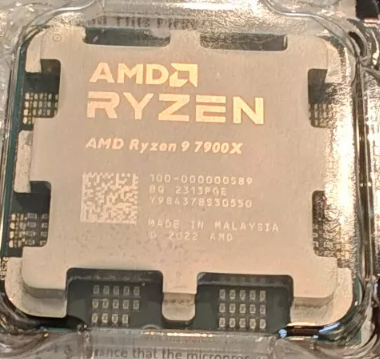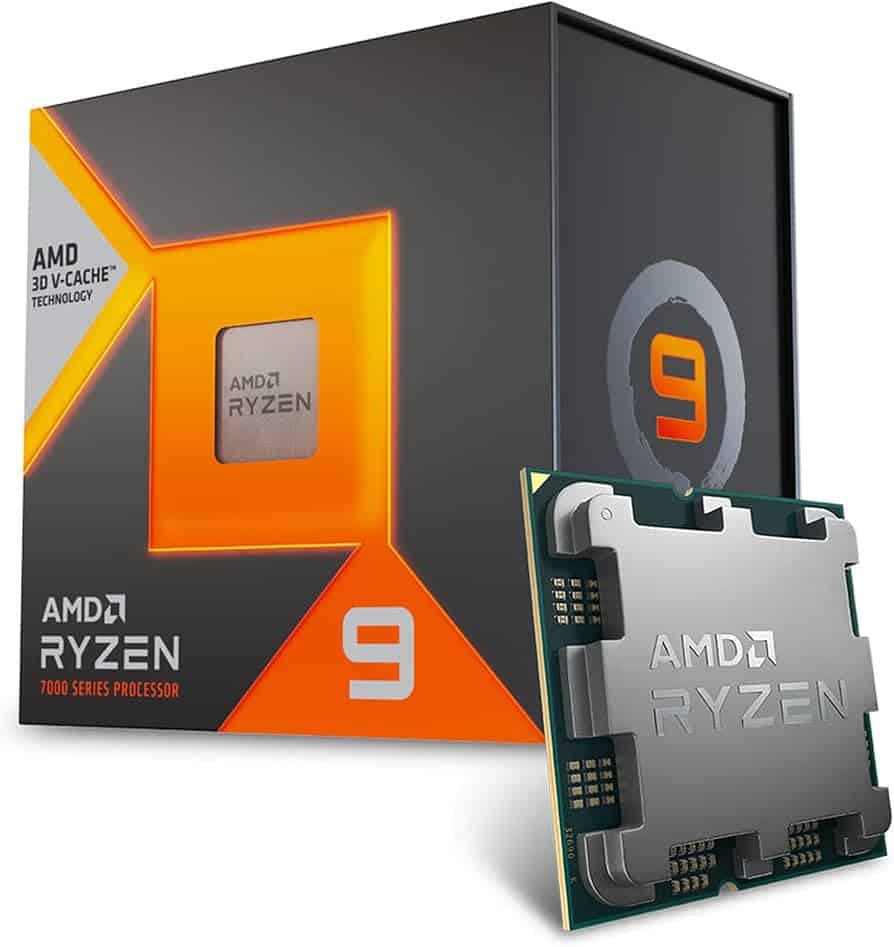AMD’s Ryzen 9 7900X and 7900X3D processors offer high-end performance for desktop computing. These 12-core, 24-thread CPUs are based on AMD’s Zen 4 architecture and manufactured using TSMC’s 5nm process. The key difference lies in the 7900X3D’s 3D V-Cache technology, which provides additional L3 cache for improved gaming performance.
The 7900X boasts a higher base clock speed of 4.7 GHz compared to the 7900X3D’s 4.4 GHz. Both processors share the same maximum boost clock of 5.6 GHz. This clock speed difference affects their performance in various applications, with the 7900X potentially outperforming in tasks that benefit from higher base clocks.
Gamers and professionals must weigh the trade-offs between these two CPUs. The 7900X3D’s larger cache gives it an edge in gaming scenarios, while the 7900X’s higher base clock may be advantageous for certain productivity tasks. The choice depends on specific use cases and budget considerations.
AMD 7900X vs 7900X3D: Choosing the Right Ryzen 7000 Series CPU
AMD’s Ryzen 7000 series offers some powerful CPUs, but the naming conventions can be a bit confusing. Let’s break down the key differences between the Ryzen 9 7900X and the Ryzen 9 7900X3D to help you decide which one is right for you.
AMD Ryzen 9 7900X

- Cores/Threads: 12 cores / 24 threads
- Base Clock: 4.7 GHz
- Boost Clock: 5.6 GHz
- L3 Cache: 64MB
- TDP: 170W
Strengths:
- High Clock Speeds: Offers high clock speeds for excellent single-threaded performance.
- Strong Multi-Core Performance: Handles demanding applications and multitasking with ease.
Weaknesses:
- Gaming Performance: While still a capable gaming CPU, it lags slightly behind the 7900X3D in gaming-specific benchmarks.
- Higher Power Consumption: Consumes more power than the 7900X3D.
AMD Ryzen 9 7900X3D

- Cores/Threads: 12 cores / 24 threads
- Base Clock: 4.4 GHz
- Boost Clock: 5.6 GHz
- L3 Cache: 128MB (64MB CCD + 64MB V-Cache)
- TDP: 120W
Strengths:
- Gaming Performance: Excels in gaming due to its large L3 cache (V-Cache), providing incredibly high frame rates.
- Power Efficiency: Offers excellent performance per watt.
Weaknesses:
- Slightly Lower Clock Speeds: Base clock speed is slightly lower than the 7900X, but boost clock is the same.
- May Not Be Ideal for All Workloads: While strong overall, the 7900X might be slightly better for heavily multi-threaded tasks that don’t benefit as much from the larger cache.

Which CPU is Right for You?
| Feature | AMD 7900X | AMD 7900X3D |
|---|---|---|
| Ideal Use Case | General use, demanding applications, multitasking | Gaming, general use |
| Gaming Performance | Excellent | Best in Class |
| Multi-threaded Performance | Excellent | Excellent |
| Power Consumption | Higher | Lower |
| Price | Lower | Higher |
Choose the 7900X if:
- You need a well-rounded CPU for various tasks, including gaming and productivity.
- You prioritize multi-core performance and clock speeds.
- You want a more budget-friendly option.
Choose the 7900X3D if:
- Gaming is your primary focus.
- You want the absolute best gaming performance.
- You value power efficiency.
Understanding 3D V-Cache
AMD’s 3D V-Cache technology is a revolutionary advancement in CPU design. It stacks additional L3 cache vertically on top of the CPU die, dramatically increasing the amount of high-speed memory accessible to the processor. This allows the CPU to access frequently used data much faster, resulting in:
- Higher frame rates: 3D V-Cache can provide a significant boost to gaming performance, especially at higher resolutions.
- Smoother gameplay: Reduces stuttering and frame drops, leading to a more enjoyable gaming experience.
- Improved performance in some applications: Applications that rely heavily on cache can also benefit from 3D V-Cache, though the gains are generally less pronounced than in games.
The 7900X3D is a prime example of how 3D V-Cache can elevate gaming performance to new heights. If you’re a serious gamer looking for the best possible frame rates, the 7900X3D is the clear choice.
Key Takeaways
- The 7900X3D features 3D V-Cache technology for enhanced gaming performance
- Both CPUs have 12 cores and 24 threads, with different base clock speeds
- Users should consider their specific needs when choosing between these processors
Technical Specifications and Architecture Comparison
The AMD Ryzen 9 7900X and 7900X3D processors share many similarities but differ in key aspects of their design and performance capabilities. These differences impact their suitability for various computing tasks and user needs.
Core and Thread Count
Both the Ryzen 9 7900X and 7900X3D feature 12 cores and 24 threads. This configuration provides excellent multi-tasking performance for demanding workloads.
The identical core and thread count allows both processors to handle complex tasks like video editing, 3D rendering, and gaming with high efficiency. Users can expect similar performance in applications that fully utilize multi-core processing.
Base and Boost Clock Speeds
The Ryzen 9 7900X has a base clock speed of 4.7 GHz and can boost up to 5.6 GHz. In contrast, the 7900X3D operates at a lower base clock of 4.4 GHz but maintains the same 5.6 GHz boost speed.
This difference in base clock speeds may result in slightly better performance for the 7900X in single-threaded tasks. However, the impact is often minimal in real-world scenarios due to modern CPU boosting technologies.
| CPU Model | Base Clock | Boost Clock |
|---|---|---|
| 7900X | 4.7 GHz | 5.6 GHz |
| 7900X3D | 4.4 GHz | 5.6 GHz |
Cache Architecture and Size
The most significant difference between these processors lies in their cache architecture. The 7900X3D incorporates AMD’s 3D V-Cache technology, dramatically increasing its L3 cache size.
The 7900X features 64MB of L3 cache, while the 7900X3D boasts an impressive 128MB. This larger cache allows the 7900X3D to store more data closer to the CPU cores, potentially reducing latency and improving performance in certain applications, especially gaming.
Both processors maintain the same L1 and L2 cache sizes, with 64KB of L1 cache per core and 1MB of L2 cache per core.
Thermal Design Power (TDP) and Energy Efficiency
The Ryzen 9 7900X has a TDP of 170W, while the 7900X3D operates at a lower 120W TDP. This difference impacts power consumption and thermal output.
The lower TDP of the 7900X3D may result in reduced energy costs and easier thermal management. It can be particularly beneficial for users with smaller form factor builds or those prioritizing energy efficiency.
Both processors support AMD’s Precision Boost Overdrive (PBO) technology, allowing for automatic overclocking within safe thermal and power limits.
Supported Technologies and Chipset Compatibility
The Ryzen 9 7900X and 7900X3D are built on AMD’s Zen 4 architecture and support the latest technologies:
- PCIe 5.0 connectivity
- DDR5 memory support
- AMD EXPO (Extended Profiles for Overclocking) for memory optimization
Both CPUs are compatible with Socket AM5 motherboards, ensuring a wide range of options for system builders. They work with X670, X670E, B650, and B650E chipsets, offering flexibility in feature sets and price points.
The processors support AMD’s Smart Access Memory technology, enabling improved performance when paired with compatible AMD graphics cards.







